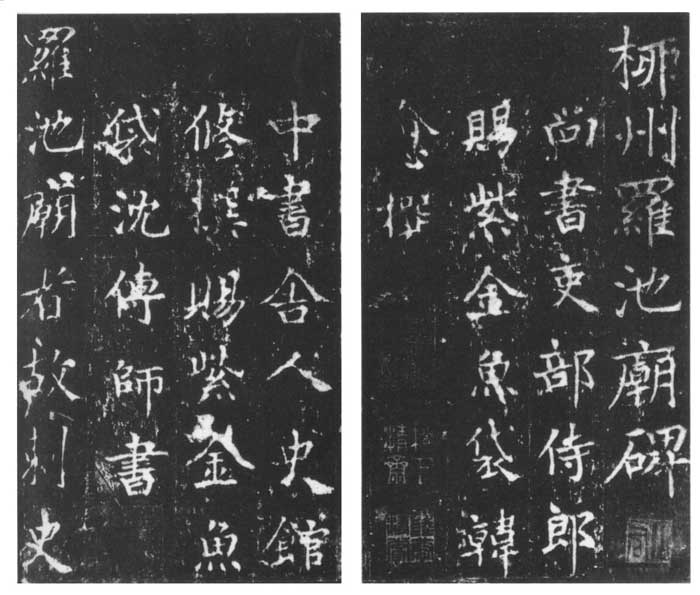Shen Chuanshi (769-827), courtesy name Ziyan, was born in Wuxian County, Suzhou. He was promoted to Jinshi at the end of Zhenyuan (785--805) of Emperor Dezong of the Tang Dynasty. He later moved to Prince's School, Hanlin Bachelor, Zhongshu Sheren, Hunan Observer, and Baoli. In the first year of his reign (825), he was appointed Minister Youcheng and Minister of the Ministry of Personnel. There is a biography in the old Tang Dynasty book.
Regarding Shen Chuanshi's calligraphy, Zhu Changwen listed him as a masterpiece with Yu, Ou, Chu, Liu, etc. in "Xu Shu Duan". He is said to be "the best in both his formal and running calligraphy. It is preserved in Cuiyan and he can move forward quickly. He is so vigorous and imitative, his bones are light and his spirit is strong, and he is as if he is flying in the sky." Mi Fu in the Song Dynasty had a high vision and self-esteem. He once praised Yan There are many criticisms of his real calligraphy and few praises for other people's calligraphy. However, when he saw Shen's calligraphy, he highly praised it, saying that Shen's calligraphy is "like a dragon traveling in the sky or a tiger perched beside a stream, with calm spirit and pure bones." It shows that Chuanshi Shen was also an outstanding calligrapher in the Tang Dynasty. There is a story that Mi Fu once visited the Yuelu Temple in Daolin, western Hunan. Because he liked Shen Chuanshi's calligraphy very much, he asked the abbot of the temple if he could borrow "Poems on Yuelu Temple in Daolin" written by Shen for viewing. The monks admired his name. He loved his "madness", so he lent it to him, but he couldn't put it down. Wanting to take it as his own, he actually "ran away with it in a sail overnight", so the monk had to report it to the government in a hurry before he could recover it. I would like to know how much Lao Mi loves Shen's calligraphy and the position he holds in his heart.
Appreciation of works: Liuzhou Luochi Temple Monument

"Liuzhou Luochi Temple Monument"
"Liuzhou Luochi Temple Stele" was written by Shen Chuanshi when he was 53 years old. The inscription was written by the great writer Han Yu to commemorate and praise Liu Zongyuan's political achievements after he was demoted to Liuzhou governor. The stele was erected in Luochi Temple. The stele has long since disappeared. It is impossible to find out when it was destroyed. The rubbings we see today are photocopied from an original volume of Song rubbings collected by He Shaoji in the Qing Dynasty. Looking at the calligraphy on this stele, I can see that the breath is fresh and round, and the bones are strong. Although the knot is relatively thin, it is strong and beautiful. The flesh is hidden in the tendons, and there is no trace of sterility. At first glance, it looks similar to Liu (Gongquan) Shu, but upon closer inspection, there is a fundamental difference between Liu Shu and Liu Shu. That is, Liu Shu's palace is too restrained and so tight that people feel panicked. Shen Shu does not have this characteristic, although Zhonggong is also slightly It's restrained, but generally speaking, it's relatively loose. Another difference from Liu's calligraphy is in the structure. Shen's calligraphy is mostly low on the left and high on the right, and slightly tilted to the right. Of course, the calligraphy of this stele does have some similarities with Liu's calligraphy. Among them, the vertical The writing style of curved hooks, dots, strokes, strokes, hanging pins and vertical strokes, as well as the structure of some characters such as "yan", "诏", "liu", "shi", "bu", etc., are exactly the same as those in Liu Shu. After all, Who influenced whom? Please take a look at Wang Duo's postscript on this rubbing: "Shen Shu has few friends, Yu Yongxing is the original, Liu Chengxuan and Ou Ledeng are one family." If Wang Duo's words are to be believed, it is obvious that Master Shen inherited Master Liu. However, according to the original biography of Liu Gongquan in the "Old Book of Tang Dynasty", it is speculated that Liu (Gongquan) was nine years younger than Master Shen. At the same time, there is an interesting passage in the biography, "Gong Quan was a new student to Wang Quan." The book is full of modern brushwork, and the style is charming and unique." Maybe Shen Chuanshi is included in this "modern brushwork". For example, if you compare the "Li Sheng Stele" and the "Luochi Temple Stele" in the Liushu book, the writing and knotting are quite similar. It seems that Wang Duo's Shen "Ben" Liu Gongquan needs to be discounted. When Huang Luzhi discussed the calligraphy of the Tang Dynasty, he once said that "in the early Tang Dynasty, the calligraphy was strong and strong, which was the style of the Jin and Song Dynasties. After the Kaiyuan Dynasty, it became thicker and thicker, and after the Yuan Dynasty, the disciples of Liu and Shen returned to the Qing Dynasty." It can be seen that both Liu and Shen were calligraphers who strived to "correct the disease of obesity" and valued "purity and vigor" as their beauty. If we use today's terms, Liu and Shen were both very innovative calligraphers at that time. From this point of view, it is not surprising that Liu and Shen Shufeng are similar.








